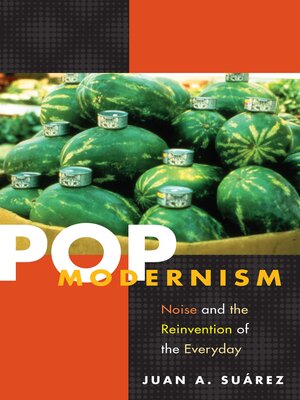
Sign up to save your library
With an OverDrive account, you can save your favorite libraries for at-a-glance information about availability. Find out more about OverDrive accounts.
Find this title in Libby, the library reading app by OverDrive.



Search for a digital library with this title
Title found at these libraries:
| Library Name | Distance |
|---|---|
| Loading... |
Pop Modernism examines the popular roots of modernism in the United States. Drawing on a wide range of materials, including experimental movies, pop songs, photographs, and well-known poems and paintings, Juan A. Suárez reveals that experimental art in the early twentieth century was centrally concerned with the reinvention of everyday life. Suárez demonstrates how modernist writers and artists reworked pop images and sounds, old-fashioned and factory-made objects, city spaces, and the languages and styles of queer and ethnic "others." Along the way, he reinterprets many of modernism's major figures and argues for the centrality of relatively marginal ones, such as Vachel Lindsay, Charles Henri Ford, Helen Levitt, and James Agee. As Suárez shows, what's at stake is not just an antiquarian impulse to rescue forgotten past moments and works, but a desire to establish an archaeology of our present art, culture, and activism.|ix Acknowledgements
1 Introduction: Modernism, Popular Practice, Noise
Noise Abatement
19 1. Reading Modernity: Vachel Lindsay's Theory of FIlm
50 2. Reading the Modern City: Paul Strand and Charles Sheeler's Manhatta
80 3. John Dos Passos's USA, the Popular Media, and Left Documentary Film in the 1930s
The Rustle of the Quotidian
119 4. The Art of Noise: The Gramophone, T. S. Eliot's The Waste Land, and the Modernist Discourse Network
141 5. Joseph Cornell and the Secret Life of Things
The Murmur of Otherness
179 6. Queer Modernism: Charles Henri Ford and Parker Tyler's The Young and Evil
208 7. Walking with Zombies: Haitian Folklore and Modernist Ethnography in Zora Neale Hurston's Tell My Horse
237 8. Inner-City Surrealism: James Agee, Janice Loeb, and Helen Levitt's In the Street
273 Notes
315 Index|"In all my years of reading, only once before have I had this kind of positive immediate reaction. I kept wondering, 'How can Suárez possibly know so much, keep all his material straight, write about it with such flair, dig up so many corpses, and say something new about The Waste Land that makes it a less odious poem?' A book of encyclopedic proportions, Pop Modernism is brilliant, and will set a new path for Modernist Studies."—Paula Rabinowitz, author of Black & White & Noir: America's Pulp Modernism
|Juan A. Suárez teaches American Studies at the University of Murcia. He is the author of Bike Boys, Drag Queens, and Superstars: Avant-Garde, Mass Culture and Gay Identities in the 1960s Underground Cinema and Jim Jarmusch.
1 Introduction: Modernism, Popular Practice, Noise
Noise Abatement
19 1. Reading Modernity: Vachel Lindsay's Theory of FIlm
50 2. Reading the Modern City: Paul Strand and Charles Sheeler's Manhatta
80 3. John Dos Passos's USA, the Popular Media, and Left Documentary Film in the 1930s
The Rustle of the Quotidian
119 4. The Art of Noise: The Gramophone, T. S. Eliot's The Waste Land, and the Modernist Discourse Network
141 5. Joseph Cornell and the Secret Life of Things
The Murmur of Otherness
179 6. Queer Modernism: Charles Henri Ford and Parker Tyler's The Young and Evil
208 7. Walking with Zombies: Haitian Folklore and Modernist Ethnography in Zora Neale Hurston's Tell My Horse
237 8. Inner-City Surrealism: James Agee, Janice Loeb, and Helen Levitt's In the Street
273 Notes
315 Index|"In all my years of reading, only once before have I had this kind of positive immediate reaction. I kept wondering, 'How can Suárez possibly know so much, keep all his material straight, write about it with such flair, dig up so many corpses, and say something new about The Waste Land that makes it a less odious poem?' A book of encyclopedic proportions, Pop Modernism is brilliant, and will set a new path for Modernist Studies."—Paula Rabinowitz, author of Black & White & Noir: America's Pulp Modernism
|Juan A. Suárez teaches American Studies at the University of Murcia. He is the author of Bike Boys, Drag Queens, and Superstars: Avant-Garde, Mass Culture and Gay Identities in the 1960s Underground Cinema and Jim Jarmusch.







